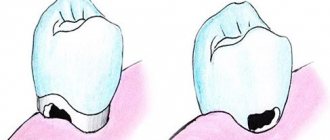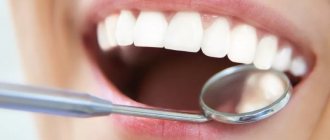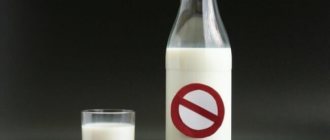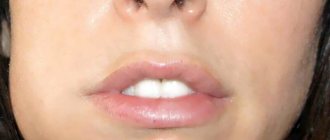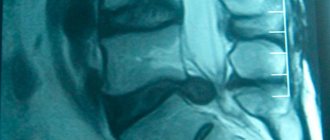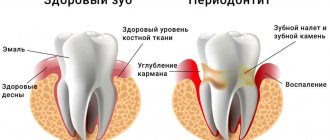Periostitis is a purulent inflammation of the periosteum, the tissue covering the bone of the upper or lower jaw. Over time, the inflammation spreads to other tissues of the oral cavity , and a painful and unpleasant abscess can grow on the gum.
Periostitis is of two types: acute and chronic . the acute one , it goes on very quickly. Inflammation is manifested by asymmetric swelling of the cheek on the side of the diseased tooth and enlargement of the lymph nodes, and an increase in temperature is observed. Chronic periostitis can pass without obvious symptoms, while negatively affecting the condition of the child’s teeth, destroying them from the inside. The chronic form often occurs due to untreated acute periodontitis, pulpitis or due to injury.
Why is periostitis dangerous?
It is impossible to delay the treatment of periostitis , as this can lead to very dangerous consequences:
• acute purulent periostitis – it is manifested by swelling and hardening of the gums, tooth mobility, and increased body temperature. The child's appetite and sleep deteriorate. In this situation, the baby urgently needs medical attention and hospitalization;
• and dentia - the inflammatory process can quickly spread into the bone tissue, damage the rudiments of permanent teeth and destroy them. In the future, because of this, a tooth will not be able to grow .
• f legmon – inflammation of the tissues located under the skin, accompanied by severe swelling, thickening and suppuration. If not treated in time, it can cause blood poisoning.
Causes of swelling on the cheek
Many people believe that only teeth can provoke swelling of the cheeks. In fact, the reasons may be different.
Dental diseases
Factors related to oral health can provoke the problem. Among them:
- Eruption of impacted wisdom teeth, especially if the patient is over 25 years old. If the growth is abnormal, it is recommended to remove the “eight”.
- Stomatitis affecting the cheek, gums, tongue. The disease is most often diagnosed in children, but it can also occur in adults. An advanced disease provokes swelling. The cheek hurts from the inside, in the corner of the mouth.
- Gum disease, in which pathogenic bacteria accumulate in dental plaque, causing inflammation. Thus, gingivitis is accompanied by bleeding gums, swelling, and bad breath. If the disease is neglected, it will develop into periodontitis, a more serious problem.
Complications in the form of swelling of the cheek can develop after endodontic treatment. If during the procedure the canals are not washed and cleaned well enough, inflammation develops in the pulp chamber. The pathogenic process spreads to the bone, gum and cheek. This is how purulent periostitis develops, which is popularly called “flux”. If the disease is not treated in time, phlegmon and sepsis may develop, which pose a health hazard.
During the recovery period after tooth extraction, swelling of the cheek may also be observed. More often the symptom appears if the intervention was performed on the lower jaw. This problem often arises after implantation. This is the body's reaction to traumatic actions. It goes away in a few days. Otherwise, you need to consult a dentist, who must confirm or rule out the presence of a complication. It can develop due to infection getting into the wound, which threatens the manifestation of peri-implantitis.
Infectious, colds and other diseases
Cheek swelling is one of the symptoms of such diseases:
- Parotitis. When the disease occurs, the salivary glands become inflamed, which explains why soft tissues swell.
- Lymphadenitis. It occurs as an independent disease or as a complication of other ailments, such as diseases of the ENT organs. With lymphadenitis, the cervical, parotid and submandibular lymph nodes become enlarged, and the cheek becomes inflamed.
- Otitis, sinusitis, sinusitis. The inflammatory process can spread to the cheek, under the eye, and the area near the nose.
Pathological processes in gingival tissues often provoke inflammation of the salivary ducts and glands. It can also be an independent disease. It is caused by stones in the ducts, cysts, tumors.
The mucous membrane also swells with inflammation of the trigeminal nerve. In this case, other symptoms appear: numbness, pain radiating to the ear, “lumbago”. Swelling is a common occurrence in diseases of internal organs. Excess fluid due to malfunction of one or another organ accumulates in soft tissues, including the facial area.
Other causative factors
Swelling can also appear as a result of injury. This symptom accompanies soft tissue bruises, joint dislocations, and jaw fractures, which can be caused by a blow or fall. Children are more often susceptible to injury due to their excessive physical activity. Swelling can occur due to an allergic reaction, when the body shows immunity to a certain product. Other reasons:
- severe burn (both thermal and chemical);
- insect bites, which also cause redness and induration;
- poor oral hygiene.
Cheek swelling can occur in pregnant women. The fact is that during this period hormonal changes occur in the body. As a result, the gums swell, which is reflected on the cheek.
Signs of periostitis in a child:
• aching or nagging pain in a tooth or gum. Moreover, painful sensations intensify with any touch (including during meals);
• redness and swelling of the gums;
• when a lump appears above or below a tooth;
• o tech cheeks;
• enlargement of the lymph nodes (usually on the side where the source of inflammation is located);
• bad breath ;
• elevated temperature . It may not be present, but even if the temperature is normal and other symptoms are present, the child must be taken to the doctor;
• capriciousness and lethargy of the child.
Symptoms of the disease
The reaction develops rapidly; signs of angioedema in children are swollen lips, neck, and face. The upper torso, hands, feet, and genital area are often affected. Quincke's edema is visible in the eyes of a child - the eyelids swell on one or both sides.
- When the tonsils are affected, the picture is similar to a sore throat.
- Edema of the larynx is indicated by a hoarse voice, difficulty breathing, a gusty cough, blue discoloration and then gradual paleness of the skin.
- Swelling that appears in one area may occur in another. This mainly applies to large-scale swelling.
- When the mouth and tongue swell, speech becomes difficult.
- If the process is localized in the gastrointestinal tract, the child may complain of tingling of the tongue, followed by diarrhea and vomiting, and sharp pain in the intestinal area.
- Rarely, swelling of the meninges occurs. With it, the child cannot fully tilt his head forward, complains of a headache, and behaves inhibited. Convulsions and vomiting may occur.
- If only the skin is affected, joint pain, fever may appear, and the child may lose consciousness.
The pathological condition can last from an hour to several days.
How does angioedema begin in a child?
Immediately after contact with the allergen, the listed symptoms increase sharply. This happens in a matter of minutes. Source: G. I. Smirnova. Urticaria and Quincke's edema // Allergic diseases in children. Ed. M.Ya. Studenikina, I.I. Balabolkina. M.: Medicine, 1998: 279-287 If you press on the swollen area, the child will not experience pain, but you will feel a dense swelling, on which, after pressing, there will be no characteristic depression.
Causes of periostitis:
• of thorough oral care Small children do not yet know how to properly take care of their teeth, so plaque and food debris accumulate in the gum pockets, which can cause inflammation;
• injury to the gums . Children, especially toddlers, love to put almost everything in their mouths. Foreign objects can not only injure the gums, but also introduce harmful microbes into the wounds;
• to caries and its complications . Baby teeth are more vulnerable, so any defect can cause infection;
• angina , tonsillitis . _
Currently, dysarthria is a widespread disorder in childhood. For example, according to Ph.D., Associate Professor of the Department of Special Pedagogy and Psychology Vakulenko L.S. Murmansk State Pedagogical University, dysarthria occurs in 40.8% of 240 preschool children with speech pathology aged 4 to 7 years. The speech defect in question inhibits the development of speech as a whole and significantly lengthens the time required for correctional work.
The purpose of this article is to consider traditional and non-traditional techniques for one of the characteristic symptoms of dysarthria - hypersalivation, i.e. profuse salivation. The problem of eliminating increased salivation is too complex and cannot be solved only through exercises in speech therapy classes.
Preliminary work
It is necessary to teach the child to suck with closed lips, swallow saliva with his head thrown back and in a normal position. Before performing any articulation exercise, the teacher reminds the child to swallow saliva and blot the inside of the mouth with a napkin.
Recommendations.
- People around you should constantly monitor the position of the child's mouth and remind him to keep his mouth closed when he is not eating or talking.
- It is important that the child develops a differentiated sensation of dry and wet chin.
- During classes, it is necessary to pause at certain intervals and invite the child to swallow saliva.
The main stage of work
1. Cryotherapy.
Applying a piece of ice along the contour of the lips, taking into account 6 points (see Fig. 1). The duration of ice retention at each point is from 5 seconds to 1 minute (V.A. Kiseleva [4]).
| Fig.1. Diagram of the location of active points in the lip area. |
2. Rinse the mouth.
- Rinse using medicinal herbs: infusion of rose hips, oak bark, yarrow. You must first make sure that your child does not have allergies.
- Step-by-step gargling with mineral water, liquid jelly, kefir, thick jelly.
3. Speech therapy massage.
- Acupressure is performed in the area of the submandibular fossa, using the index finger to make light vibrating movements under the chin for 4-5 seconds (E.F. Arkhipova [1]).
- Acupressure is performed in the recesses under the tongue, at two points simultaneously (see Fig. 2). Massage is carried out using the index, middle finger or rake probe. Rotational movements are performed counterclockwise, no more than 6-10 seconds. Movements should not cause discomfort to the child.
Fig.2. Massage in the recesses under the tongue. - Point massage. Find parallel points under the tragus of the ears, where the jaw bones meet (correctly found points are painful). With our index fingers we make circular movements along the points for 5 minutes clockwise (2.5 minutes with the mouth open, 2.5 minutes with the mouth closed) and 5 minutes counterclockwise (similar) (V.A. Kiseleva [4] ).
- Massage of the soft palate. Stroking and kneading movements with a finger along the midline of the hard and soft palate from the upper incisors to the uvula to obtain a pronounced pharyngeal reflex (V.A. Kiseleva [4]).
4. Chewing solid food.
Instructions for parents of dysarthric children:
- We gnaw, chew, swallow - carrots.
- We gnaw on crackers, bagels, dryers.
5. Static and dynamic facial and articulation exercises (E.M. Kosinova [5], O.A. Novikovskaya [7]).
- Imitation of yawning, chewing, swallowing with the head thrown back. (Chewing and swallowing is recommended to be done with the mouth closed).
- “Chicks” (“Window”). Open your mouth wide and hold it in this position for 3-5 seconds. Close your mouth. When performing the exercise, the tongue lies calmly at the bottom of the mouth. Keep your mouth open for 5-10 seconds.
- "Mustache." Hold a strip of paper, cocktail tubes of different diameters, a wooden or metal spatula, and medicine bottles of different diameters with your lips.
- "Fat guy - skinny guy." Puffing up both cheeks at the same time. Retraction of the cheeks into the oral cavity with the mouth open and lips closed.
- "Balloons". Inflate one cheek - deflate. Then inflate another and deflate. Inflate alternately 4-5 times.
- “Yogi exercise” - the mouth is open, the child rotates his tongue in front of the mouth, then the speech therapist invites him to swallow saliva.
- "Dry your tongue." Roll your tongue into a tube and suck air into yourself through the tube.
6. Activate muscles using honey or bread ball.
- Place a bread ball (crushed vitamins, drop 1-2 drops of syrup from a pipette) on the tip of your tongue, and forcefully make swallowing movements.
- Place a drop of honey on the tip of your tongue. Do the “Clock” exercise or move your tongue back and forth.
7. Breathing exercise “Storm in a glass.” Pour water into a glass. Take a juice straw and blow through it. Be careful not to puff out your cheeks.
8. Pronunciation of vowels: a, e, and on a solid attack (V.A. Kiseleva [4]).
- a a a; uh uh; and and and;
- ae, ae, ae; ea, ea, ea; ai, ai, ai; hey, hey, hey;
- aei, aei, aei.
Based on our practical experience, with systematic work, salivation disappears after 3 months.
Treatment of periostitis
The main thing to remember is that you cannot try to treat periostitis on your own . There are several actions that absolutely cannot be performed while waiting for a doctor’s appointment, so as not to aggravate the disease:
• apply hot compresses , rinse with soda or drink hot drinks and decoctions. Heat will only increase swelling;
• give painkillers , and even more so antibiotics;
• try to cut the abscess yourself .
Which doctor should I contact?
If you have a swelling of the cheek, you should first consult a dentist.
If the cause of the swelling is not dental, your doctor will refer you to other specialists:
- see a therapist for bacterial and viral infections;
- see a neurologist for neurological diseases;
- to an ENT specialist for inflammation of the ear and salivary gland;
- see a nephrologist for kidney pathologies;
- see a traumatologist or maxillofacial surgeon for trauma to the lower jaw.
Read also: Treatment of bronchitis in adults with antibiotics
Causes of diathesis in children
Diathesis in an infant on the cheeks or other parts of the body is not a specific disease, but a predisposition to the development of pathological reactions to irritants. This is considered a feature of the body that determines its reactivity. At the same time, against the background of diathesis, certain diseases may develop under the influence of unfavorable factors.
The causes of diathesis itself can be:
- unfavorable course of pregnancy;
- past infectious diseases during pregnancy;
- abuse of medications and bad habits during pregnancy;
- hypoxia or asphyxia of the fetus during childbirth;
- too little or too much birth weight;
- pathologies of the central nervous system;
- artificial feeding;
- dysbacteriosis;
- chronic diseases;
- insufficient or poor care;
- vaccination.
Diagnosis and treatment of diathesis
The doctor determines how to treat diathesis on the cheeks of a child depending on the diagnosis performed. It includes a general urine test, general and biochemical blood tests, an immunological examination, and a stool test for dysbacteriosis. In case of lymphatic-hypoplastic diathesis, additional examinations are required: radiography of the respiratory organs, ultrasound of the liver, lymph nodes, spleen and adrenal glands.
How to treat diathesis in children under one year of age and older:
- Follow the diet and feeding schedule prescribed by your doctor.
- Introduce complementary foods no earlier than 6 months.
- Limit consumption of cow's milk.
- Enrich your diet with vitamins.
- Use prescribed medications: antihistamines, absorbents, vitamins, antipruritics.
As a local treatment, an ointment made according to the original recipe “PsorMak” is used. It does not contain hormones or other harmful components, and contains only natural ingredients that are gentle on the skin.
If in childhood a child undergoes a course of effective treatment for diathesis, then he has every chance of not encountering complications and being absolutely healthy in adulthood. Here it is important to contact a specialist in time. The PsorMak clinic practices an individual approach to the treatment of each patient, developing not only a treatment regimen, but also a diet, as well as a prevention program.
Contact us through the form on the website or by calling +7 (495) 150-15-14. We will help you form a correct understanding of the disease itself and its treatment at all stages.
Diet
Diathesis in children responds well to treatment if the recommended diet is followed.
During breastfeeding, the baby's mother should adhere to it. Allergenic foods (sweets, citrus fruits, eggs, honey, etc.) are excluded. During the introduction of complementary foods, in order to avoid the development of diathesis, the baby’s skin reactions to the new product should be monitored, and if signs of illness appear, exclude it for three to five months, until the next attempt. After the introduction of complementary foods, the basis of the menu should be cereals, lean meat and fish, vegetables and fruits. The consumption of sweets and foods high in food additives should be limited as much as possible. Contact us!
Specialists at the PsorMak Skin Diseases Center have been successfully treating diathesis in children for many years. Contact us for an initial consultation, our doctors will help you develop a complete understanding of how to properly treat the disease in the acute stage (with skin rashes). In addition, we will help you create a dietary diet and suggest what other measures to correct the child’s lifestyle should be taken to improve his health and effectively combat the disease. Make an appointment by calling +7 (495) 150-15-14,

